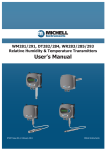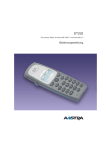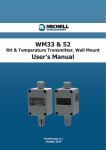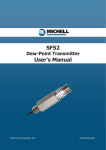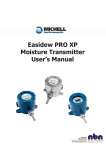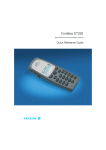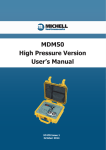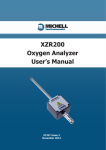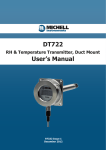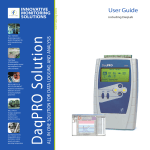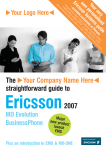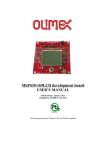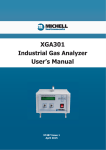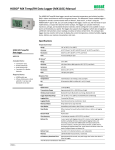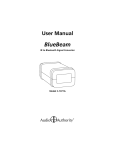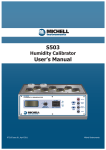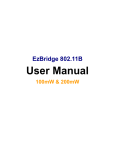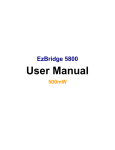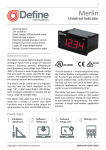Download WM281 291 User`s Manual.indd
Transcript
WM281/291 Premium Wall Mount RH & Temperature Transmitters’ User’s Manual T : 2 4. 5 H: 45.7 DP : 1 1 . 25 (ºC) 97463 Issue 1 July 2014 F Please fill out the form(s) below for each instrument that has been purchased. Use this information when contacting Michell Instruments for service purposes. Transmitter Code Serial Number Invoice Date Location of Instrument Tag No Transmitter Code Serial Number Invoice Date Location of Instrument Tag No Transmitter Code Serial Number Invoice Date Location of Instrument Tag No WM281/291 Transmitters For Michell Instruments' contact information please go to www.michell.com © 2014 Michell Instruments This document is the property of Michell Instruments Ltd. and may not be copied or otherwise reproduced, communicated in any way to third parties, nor stored in any Data Processing System without the express written authorization of Michell Instruments Ltd. WM281/291 User’s Manual Contents Safety.................................................................................................................................vi Electrical Safety............................................................................................................vi Toxic Materials..............................................................................................................vi Repair and Maintenance................................................................................................vi Calibration....................................................................................................................vi Safety Conformity.........................................................................................................vi Abbreviations......................................................................................................................vii Warnings............................................................................................................................vii 1 2 3 INTRODUCTION.................................................................................................1 INSTALLATION...................................................................................................3 2.1 Unpacking the Instrument.................................................................................... 3 2.2 Choice of the Site of Installation........................................................................... 3 2.3 Element Filter Assembly....................................................................................... 4 2.4 Wall Mounting..................................................................................................... 4 2.5 Connections........................................................................................................ 5 2.5.1 Electrical Connection...................................................................................... 5 2.5.2 Earth Connection........................................................................................... 5 2.5.3 Power Supply................................................................................................. 5 2.5.4 Digital Serial Interface.................................................................................... 6 2.5.4.1 Modbus Register Holding Map......................................................................... 6 2.6 Analog Output Configuration................................................................................ 6 2.7 Interchangeable Sensor Module............................................................................ 7 2.8 Calibration Reference Equipment.......................................................................... 7 2.9 Certificate of Conformity...................................................................................... 7 OPERATION.......................................................................................................8 3.1 Digital Display and Operation Keys........................................................................ 8 3.1.1 Open Sub-Menus........................................................................................... 8 3.1.2 Protected Sub-Menus..................................................................................... 9 4digicor2 280/290 configuration SOFTWARE...............................................11 4.1 Hardware RS485 Installation.............................................................................. 11 4.1.1 Connections................................................................................................. 11 4.2 Software Installation.......................................................................................... 11 5 MAINTENANCE.................................................................................................12 5.1 Replacing the Interchangeable I7000 Module...................................................... 12 Figures Figure Figure Figure Figure 1 2 3 4 Operating Graph..........................................................................................3 WM291.......................................................................................................4 Electrical Connections..................................................................................5 I7000 Sensor Pin Connector.......................................................................12 iv 97463 Issue 1, July 2014 WM281/291 User’s Manual Appendices Appendix A Technical Specifications . ............................................................................ 14 Appendix B Modbus Holding Register Map..................................................................... 16 B.1 Current Mapping of Modbus Holding Registers................................ 16 Appendix C Digicor2 280/290 Communications Kit (Optional).......................................... 20 Appendix D EC Declaration of Conformity....................................................................... 22 Appendix E Quality, E.1 E.2 E.3 E.4 E.5 E.6 E.7 E.8 E.9 Appendix F Recommended Practices in Humidity Measurements..................................... 29 Appendix G Return Document & Decontamination Declaration......................................... 34 Recycling & Warranty Information.................................................... 24 Pressure Equipment Directive (PED) 97/23/EC................................ 24 Recycling Policy ........................................................................... 24 WEEE Compliance......................................................................... 24 RoHS2 Compliance....................................................................... 25 Warranty...................................................................................... 25 REACH Compliance....................................................................... 26 Calibration Facilities...................................................................... 26 Return Policy................................................................................ 27 Manufacturing Quality................................................................... 27 Michell Instruments v WM281/291 User’s Manual Safety The manufacturer has designed this equipment to be safe when operated using the procedures detailed in this manual. The user must not use this equipment for any other purpose than that stated. Do not apply values greater than the maximum value stated. This manual contains operating and safety instructions, which must be followed to ensure the safe operation and to maintain the equipment in a safe condition. The safety instructions are either warnings or cautions issued to protect the user and the equipment from injury or damage. Use competent personnel using good engineering practice for all procedures in this manual. Electrical Safety The instrument is designed to be completely safe when used with options and accessories supplied by the manufacturer for use with the instrument. Toxic Materials The use of hazardous materials in the construction of this instrument has been minimized. During normal operation it is not possible for the user to come into contact with any hazardous substance which might be employed in the construction of the instrument. Care should, however, be exercised during maintenance and the disposal of certain parts. Repair and Maintenance The instrument must be maintained either by the manufacturer or an accredited service agent. For Michell Instruments’ contact information please go to www.michell.com. Calibration Refer to details in Section 3.1.2 regarding recalibration of transmitters in order to adjust their calibration in accordance with reference samples or an external reference device. This can be undertaken via the keypad on the display versions or by using the RS485 Modbus interface on all versions. Safety Conformity This product meets the essential protection requirements of the relevant EU standards and directives. vi 97463 Issue 1, July 2014 WM281/291 User’s Manual Abbreviations The following abbreviations are used in this manual: A °C °F g/m3 g/kg kJ/kg km mA mm m/sec RH s T V ampere degrees Celsius degrees Fahrenheit grams per cubic meter grams per kilogram kilojoules per kilogram kilometer milliampere millimeter meters per second relative humidity second temperature volt Warnings The following general warning listed below is applicable to this instrument. It is repeated in the text in the appropriate locations. Where this hazard warning symbol appears in the following sections it is used to indicate areas where potentially hazardous operations need to be carried out. Where this symbol appears in the following sections it is used to indicate areas of potential risk of electric shock. Michell Instruments vii WM281/291 User’s Manual 1 INTRODUCTION INTRODUCTION The 280/290 Series Transmitters are microprocessor-based instruments used to measure relative humidity and air temperature. These products are available in four different model types: • WM281/WM291 Premium Wall Mount Transmitter range • DT282/DT292 and DT284/DT294 Premium Duct Mount Transmitter range • WR283/WR293 Premium Wall Mount Remote Transmitter range • PR285 Premium Pressurized Remote Transmitter range This manual is for the WM281/291 versions only. The 280/290 Series Transmitters have two analog outputs for temperature and relative humidity respectively providing 4-20 mA, 0-20 mA, 0-10 V, 0-1 V and 0-5 V. There is a third analog output which is calculated providing 4-20 mA, 0-20 mA, 0-10 V, 0-1 V and 0-5 V. The 290 Series Transmitters are equipped with an LCD display mounted in the cover of the housing, making it possible to display the temperature, relative humidity and a value set at the third calculated output. The key features are: • Dual voltage or dual 4-20 mA outputs • Digital RS485 Modbus output • Traceable calibration certificates • Interchangeable sensor module • Optional LCD display The third analog output is configurable by the user through the Comms Kit or display version and indicates one of the following calculated values: Dew point The temperature at which a mixture of gas and water vapor must be cooled (at constant pressure) for condensation to begin to form in the liquid phase, i.e. the temperature at which a gas becomes saturated in equilibrium on a flat surface of water. The unit of measure is degrees Celsius (°C), or can be set to degrees Fahrenheit (°F). Michell Instruments 1 INTRODUCTION WM281/291 User’s Manual Frost point The temperature at which a mixture of gas and water vapor must be cooled (at constant pressure) so that condensation begins in the solid phase, i.e. the temperature at which a gas becomes saturated in equilibrium on a flat surface of ice. The unit of measure is degrees Celsius (°C), or can be set to degrees Fahrenheit (°F). Absolute humidity The mass of vapor present in the unit of volume of humid gas at defined temperature and pressure levels. The unit of measure is 1g of water/cubic meter (g/m3). Mixing ratio ( or title) The ratio between the mass of water vapor and the mass of dry gas contained in the sample of gas. The unit of measure is 1g of water/kilogram of dry air (g/kg). Specific enthalpy (heat content) The heat required to bring 1kg of dry air (and the vapor contained in it) to a constant pressure from the state of 0°C ( air + liquid water) to the state of a gaseous mixture at temperature 't'. 2 97463 Issue 1, July 2014 WM281/291 User’s Manual INstallation 2 INSTALLATION 2.1 Unpacking the Instrument On delivery please check that all the following components are present in the packing box: 2.2 • WM281 or WM291 Premium Wall Mount Transmitter • Certificate of calibration • User’s manual • Digicor2 280/290 configuration software and communication kit (optional) Choice of the Site of Installation The installation site choice for the transmitter must be made bearing in mind the effectiveness of air circulation. The point at which the sensor is installed must be typical of the surrounding environment where the measurements of relative humidity are to be taken. The following should be avoided in keeping with good instrumentation practice: • Installation location not representative of measuring conditions • Installation location adjacent to high power sources The operating envelope of the measurement probe is detailed in the following operating graph: RH% 100 80 78 50 40 20 -28 0 Figure 1 55 70 80 85 Temp °C Operating Graph Michell Instruments 3 WM281/291 User’s Manual INSTALLATION 2.3 Element Filter Assembly The filter is a fundamental element for a relative humidity transmitter, ensuring excellent protection against dust pollution and high-speed air flow, and a good level of resistance against chemical pollutants which are harmful for the sensor. The filter allows the sensor to ‘breathe’ the humidity contained in the environment to be measured and it is therefore very important to keep it clean. The WM281/291 Transmitters can be equipped with the following filter models: Standard - Delrin cap with steel mesh filter for use in environments which are relatively clean and where there is poor ventilation. H2 Sintered steel filter for use in dusty environments. Sintered steel filter with PTFE coating for use in environments where there is a risk J2 of saturation and/or where aggressive chemical substances (solvents and acids) are present. Z7 Delrin cap with PTFE filter. K7 2.4 Wall Mounting It is recommended that the WM281/291 Transmitters are installed with the measurement probe facing downwards so as to minimize the propagation of heat between the transmitter housing and the measuring element. Figure 2 4 WM291 97463 Issue 1, July 2014 WM281/291 User’s Manual 2.5 Connections 2.5.1 Electrical Connection INstallation 15 - 27 V AC and 18 - 38 V DC 1 2 3 4 5 6 7 8 9 10 11 12 13 14 Applicable for the following products: WM281/291 Pin 1 Power supply + 2 Power supply 3 RS485 system 0v 4 Ground 5 Output Channel 1 Temperature + 6 Output Channel 1 Temperature 7 Output Channel 2 RH + 8 Output Channel 2 RH 9 RS485 Data + 10 RS485 Data 13 Output Channel 3 Calculated + 14 Output Channel 3 Calculated Do not connect Pin 2 (V-) to Pin 4 (Ground) Figure 3 Electrical Connections The electrical connection box is located in the main body of the WM281/291 Transmitters. Undo the four screws on the face of the transmitter and carefully lift up the top panel. The connector is located on the circuit board. 2.5.2 Earth Connection A suitable shielded conductor cable with a diameter between 5 and 10mm should be used for entry and exiting the transmitter housing via the 2 x PG11 metal glands. The shielded cable must be suitably grounded to ensure electromagnetic protection. 2.5.3 Power Supply The power supply required to power the system is: • 18 V to 38 V DC • 15 to 27 V AC The DC and AC power supply enter via the same pcb connection pins. Michell Instruments 5 INstallation 2.5.4 WM281/291 User’s Manual Digital Serial Interface The WM281/291 Transmitters are equipped with an RS485 communication port which provides users with the following features: • RS485 Modbus output for use as a control signal within a single or multidrop system • All transmitter variables and diagnostics can be accessed and modified using the Digicor2 Communications Kit, available from Michell. • With use of suitable calibration equipment and trained personnel, unit recalibration can be performed 2.5.4.1 Modbus Register Holding Map Please refer to Appendix B. 2.6 Analog Output Configuration On the WM281/291 Transmitters, configuration of the three analog outputs can be achieved automatically via the RS485 Modbus interface with the Digicor2 Configuration Software (see Section 4) or on the WM291 manually via the LCD display keypad. Output Channel 1 • The output signal is equal to the range -30 to +70°C (-22 to +158°F) (unless another output scale is ordered) Output Channel 2 • The output signal is equal to the range 0 to 100% RH Output Channel 3 • Dew point range -99.9 to +212 (includes both °F and °C) • Frost point range -99.9 to +212 (includes both °F and °C) • Mixing ratio range (g/kg) 0 to 500 g/kg • Absolute humidity range (g/m3) 0 to 600 g/m3 • Enthalpy range -40 to +1500 kJ/kg These are the electronic minimum/maximum limits which the transmitter is capable of calculating. 6 97463 Issue 1, July 2014 WM281/291 User’s Manual 2.7 INstallation Interchangeable Sensor Module The WM281/291 Transmitters are equipped with the interchangeable, Hygrosmart I7000 sensor module. The ‘plug-in’ type connection allows for a rapid, low-cost replacement operation, and significantly reduces maintenance costs. The labels of all I7000 sensor modules include: 2.8 • the serial number • the date of calibration Calibration Reference Equipment The following calilbrators are available for the WM281/291 Transmitters: 2.9 • 503 - Humidity calibrator - for calibration checking purposes • S904 - Humidity calibrator - for calibration purposes • Optical cooled mirror calibrator - for laboratory calibration purposes Certificate of Conformity The WM281/291 Transmitters are delivered with a Certificate of Conformity and a calibration report for each individual transmitter. Michell Instruments 7 WM281/291 User’s Manual 3 OPERATION 3.1 Digital Display and Operation Keys Applicable to WM291 Transmitter only F The WM291 Transmitter can be configured manually through the following 8 sub-menus. Press and hold the F (Function) key and then single press the (up) key to allow selection of any of the required sub-menus below: Once the required sub-menu is reached, edit by pressing the key, then choose the value by pressing the (up) and (down) keys and confirm by pressing the key. To exit the sub-menu press the F (Function) key then press the (up) key and scroll to the normal measurement screen. 3.1.1 Open Sub-Menus These are open menus which can be accessed and amended with no password protection. 1. 2. 8 Information • Model type • Password Configuration • LCD contrast • LCD back light • Temperature Filter from 0 - 20 s • Humidity Filter from 0 - 20 s • Temperature unit 97463 Issue 1, July 2014 WM281/291 User’s Manual 3.1.2 OPERATION Protected Sub-Menus These are password protected menus and should only be accessed by trained personnel key, entering a password of 99 and then pressing the key by pressing the again. This gives access to the sub-menus 3 to 8 below. Once the required protected sub-menu changes are made, the unit is reset into protected mode by changing the password from 99 to any other value or by power supply disconnection. 3. Out Temperature • Out type: 4-20 mA, 0-20 mA, 0-10 V, 0-1 V, 0-5 V • Low scale * • High scale * * refer to Section 2.6.1 for setting range 4. Out RH • Out type: 4-20 mA, 0-20 mA, 0-10 V, 0-1 V, 0-5 V • Low scale* • High scale* * refer to Section 2.6.1 for setting range 5. Out Value Calculate • Out type: 4-20 mA, 0-20 mA, 0-10 V, 0-1 V, 0-5 V • Low scale* • High scale* * refer to Section 2.6.1 for setting range 6. 7. Serial • Code 1 (address) • Protocol (MODBUS) • Rate • Parity Temperature Calibration • Set temperature • Restore factory settings NOTE: Changes to some of these settings may lead to the loss of calibration data and should only be changed by qualified personnel when absolutely necessary. Michell Instruments 9 WM281/291 User’s Manual OPERATION 8. RH Calibration • Set RH • Restore factory settings NOTE: Changes to some of these settings may lead to the loss of calibration data and should only be changed by qualified personnel when absolutely necessary. 10 97463 Issue 1, July 2014 WM281/291 User’s Manual 4 configuration SOFTWARE digicor2 280/290 configuration SOFTWARE AND COMMUNICATIONS KIT For more details refer to Appendix C. 4.1 Hardware RS485 Installation To reconfigure the set-up of the WM281/291 Transmitters, Communications Kit Digicor2 must have been ordered and this is supplied with the following components: 4.1.1 • Configuration Software CD • RS485 to USB convertor • RS485 to USB connection instructions Connections Connect the 2 RS485 flying lead wires into the green pcb connector as per Section 2.5.1. Insert the USB connector into the PC and follow the instructions as in Section 4.2 below. 4.2 Software Installation To install the Digicor2 software, make sure all running Windows applications are closed before inserting the CD into the CD-ROM drive and installing the Product Application software. Follow the instructions below to install the software: 1. Run the ‘Digicorapplication.exe’ file 2. To install the software click ‘Next’ 3. For final installation click ‘Install’ 4. Once installation of the Digicor2 software has been completed, click on the ‘Finish’ button. The Digicor2 program is now ready to use. Instructions of how to use the software are available on the help menu within the software. Michell Instruments 11 WM281/291 User’s Manual MAINTENANCE 5 MAINTENANCE 5.1 Replacing the Interchangeable I7000 Module Figure 4 I7000 Sensor Pin Connector The following steps should be taken to carry out the replacement of the I7000 module: 1. Switch off the power supply to the transmitter. 2. Unscrew the protection filter mounted on the measurement probe body. NOTE: Be careful not to apply any force to the filter protection cage. 3. Taking care not to bend the male pins on the sensor electrical connector, remove the I7000 to be replaced and insert the new component. 4. Ensure that the appropriate adhesive label (with the date of calibration) is attached to the transmitter housing. 5. Carefully screw the protection filter back on. Michell Instruments delivers each interchangeable module with an identification label which must be attached to the transmitter housing over the previous label. If a transmitter is returned to the factory for repair or maintenance without the appropriate label of the corresponding interchangeable module, the warranty shall be considered as invalid. 12 97463 Issue 1, July 2014 WM281/291 User’s Manual appendix a Appendix A Technical Specifications Michell Instruments 13 WM281/291 User’s Manual appendix a Appendix A Technical Specifications Performance Specifications Measurement Range (RH) Measurement Range (T) Accuracy at 23°C (73°F) Humidity Accuracy at 23°C (73°F) Temperature Stability – RH Sensor Response Time – RH Sensor 0 to 100% RH -30 to +70°C (-22 to +158°F) <±2% RH (5–95% RH) ±0.4°C (±0.72°F) <±1% RH/year <10 sec typical (for 90% of the step change) Electrical Output/Input Specifications 0–1, 0–5, 0–10 V 0–20 mA, 4–20 mA, RS485 15 - 27 V AC and 18 - 38 V DC Current output: R ≤ 500 Ω 1.7 W maximum 2004/108/EC Output Signal Supply Voltage Load Resistance Power Consumption CE Conformity Operating Specifications Operating Temperature Probe -30 to +85°C (-22 to +185°F) Housing -20 to +70°C (-4 to +158°F) Storage -30 to +70°C (-22 to +158°F) Mechanical Specifications Ingress Protection Material IP65 (NEMA 4 level) Housing Aluminum die casting Probe Delrin Dimensions Housing 120 x 120 x 49.5mm (4.72 x 4.72 x 1.94”) Probe L=100mm ø19mm (L=3.93” ø0.74”) 450g (15.87oz) Screw terminals via PG11 metal glands LCD, 2 lines x 16 characters Weight Electrical Connections Display Resolution RH% 100 80 78 50 Operating conditions 40 20 -28 0 55 70 80 85 Temp °C 14 97463 Issue 1, July 2014 WM281/291 User’s Manual appendix B Appendix B Modbus Holding Register Map Michell Instruments 15 WM281/291 User’s Manual appendix B Appendix B B.1 Modbus Holding Register Map Current Mapping of Modbus Holding Registers Address Parameter Access Type Min Value Max Value Default Decimal Points Unit Description 0 Temperature Reading R - - - 2 °C/°F Returns present value of temperature channel 1 Humidity Reading R 0.0 100.0 - 1 % Returns present value of humidity channel 2 RESERVED R - - 0 0 - - 3 Model Type R - - - 0 - Returns device model type value 4 RESERVED R - - 0 0 - - 5 Calculated Variable Reading R - - - 1 - Returns present value of calculated channel 6-7 Current input Reading R 96 480 - 2 mV 8– 9 RESERVED R - - 0 0 - 10 Actual Low Temperature Scale R - - -30.0 1 °C Returns fixed value -30°C 11 Actual High Temperature Scale R - - 140.0 1 °C Returns fixed value 140°C 14 Board Type R - - 0x0430 or 0x0C08 0 - Returns board type identifier Read 0x0430 on MS430 board & Read 0x0C08 on HC08 board 15 – 22 RESERVED R - - 0 0 - - 23 Temperature Offset Correction (Single Point Calibration) R/W -999 999 0 2 °C 24 Digital Temperature Filter R/W 0.0 20.0 0.8 1 Seconds 40 – 44 RESERVED R - - 0 0 - - 45 Baud rate R/W 0 4 4 0 - Get/Set COM Baud rate setting 0 = 1200, 1 = 2400, 2 = 4800, 3 = 9600, 4 = 19200 46 ModBus Slave ID R 0 247 - 0 - Returns ModBus Slave ID of device 47 Parity R/W 0 2 0 0 - Get/Set COM Parity setting 0 = None, 1 = Odd, 2 = Even 48 – 49 RESERVED R - - 0 0 - - 50 Temperature Open/ Under range Counter value R 0 65535 0 0 - Returns count value for number of times the device has gone below Temperature under limit 51 Temperature Saturate/Over range Counter value R 0 65535 0 0 - Returns count value for number of times the device has gone above Temperature over limit 52 Humidity Open/ Under range Counter value R 0 65535 0 0 - Returns count value for number of times the device has gone below Humidity under limit 53 Humidity Saturate/ Over range Counter value R 0 65535 0 0 - Returns count value for number of times the device has gone above Humidity over limit Returns the voltage measured across the main connector pin which corresponds to the current input supplied - Get/Set Single Point Calibration offset for Temperature input Get/Set Digital Filter value for Temperature input 57 – 59 RESERVED R - - 0 0 - - 64 RESERVED R - - 0 0 - - 69 – 119 RESERVED R - - 0 0 - - 120 Trademark R - - 5000 0 - Reads Michell identifier in ModBus 121 Device Type identifier R - - 129 0 - Reads type of device 16 97463 Issue 1, July 2014 WM281/291 User’s Manual appendix B 122 Software Release R - - 6.00 2 - Reads Software release number in format X.XX 123 – 124 RESERVED R - - 0 0 - - 125 Type of Analog output for Temperature R/W 0 130 1 0 - Get/Set Analog output type for Temperature 0 = 0 – 20mA 1 = 4 – 20mA 128 = 0 – 1V 129 = 0 – 5V 130 = 0 – 10V 126 - 139 RESERVED R - - 0 0 - - 140 Type of Analog output for Humidity R/W 0 130 1 0 - Get/Set Analog output type for Humidity 0 = 0 – 20mA 1 = 4 – 20mA 128 = 0 – 1V 129 = 0 – 5V 130 = 0 – 10V 141 – 154 RESERVED R - - 0 0 - - 155 Low Limit of Analog output for Temperature R/W -30.0 140.0 -30.0 1 °C/°F Get/Set Minimum value of Analog output for Temperature 156 High Limit of Analog output for Temperature R/W -30.0 140.0 140.0 1 °C/°F Get/Set Maximum value of Analog output for Temperature 157 Low Limit of Analog output for Humidity R/W 0.0 100.0 0.0 1 % Get/Set Minimum value of Analog output for Humidity 158 High Limit of Analog output for Humidity R/W 0.0 100.0 100.0 1 % Get/Set Maximum value of Analog output for Humidity 159 RESERVED R - - 0 0 - - 160 Type of Analog output for Calculated Variable R/W 0 130 1 0 - Get/Set Analog output type for Calculated Variable 0 = 0 – 20mA 1 = 4 – 20mA 128 = 0 – 1V 129 = 0 – 5V 130 = 0 – 10V 161 – 174 RESERVED R - - 0 0 - - 175 Low Limit of Analog output for Dew Point R/W - - - 0 - Get/Set Minimum value of Dew Point output 176 High Limit of Analog output for Dew Point R/W - - - 0 - Get/Set Maximum value of Dew Point output 177 – 179 RESERVED R - - 0 0 - - 180 Low Limit of Analog output for Mixing Ratio R/W - - - 0 - Get/Set Minimum value of Mixing Ratio output 181 High Limit of Analog output for Mixing Ratio R/W - - - 0 - Get/Set Maximum value of Mixing Ratio output 182 Low Limit of Analog output for Absolute Humidity R/W - - - 0 - Get/Set Minimum value of Absolute Humidity output 183 High Limit of Analog output for Absolute Humidity R/W - - - 0 - Get/Set Maximum value of Absolute Humidity output 184 Low Limit of Analog output for Enthalpy R/W - - - 0 - Get/Set Minimum value of Enthalpy output 185 High Limit of Analog output for Enthalpy R/W - - - 0 - Get/Set Maximum value of Enthalpy output 186 Low Limit of Analog output for Frost Point R/W - - - 0 - Get/Set Minimum value of Frost Point output Michell Instruments 17 WM281/291 User’s Manual appendix B 187 High Limit of Analog output for Frost Point R/W - - - 0 - Get/Set Maximum value of Frost Point output 190 – 218 RESERVED R - - 0 0 - - 219 Digital Humidity Filter R/W 0.0 20.0 0.5 1 Seconds 220 Humidity Offset Correction (Single Point Calibration) R/W -999.0 999.0 0.0 1 % 221 – 399 RESERVED R - - 0 0 - - 400 Temperature Unit R/W 30 31 30 0 - Get/Set Temperature Unit 30 = °C 31 = °F 401 – 403 RESERVED R - - 0 0 - - 406 – 419 RESERVED R - - 0 0 - - - Get/Set Calculation Type 0 = Dew Point 1 = Mixing Ratio 2 = Absolute Humidity 3 = Enthalpy 4 = Frost Point 420 Calculated Variable Type R/W 0 5 0 0 Get/Set Digital Filter value for Humidity input Get/Set Single Point Calibration offset for Humidity input Get/Set LCD Contrast and Backlight Settings 421 LCD Contrast and Backlight R/W 0 128 5 0 - Bit 0 – 6 are used for LCD Contrast Level (0 to 9) Bit 7 is used for LCD Backlight control (1 = ON, 0 = OFF) 422 Michell Identifier String R - - “DI” 0 - Returns constant string “DI” 423 Michell Identifier String R - - “GI” 0 - Returns constant string “GI” 424 Michell Identifier String R - - “CO” 0 - Returns constant string “CO” 425 Michell Identifier String R - - “RT” 0 - Returns constant string “RT” 426 Michell Identifier String R - - “29” 0 - Returns constant string “29” 18 97463 Issue 1, July 2014 WM281/291 User’s Manual appendix C Appendix C Digicor2 280/290 Communications Kit (optional) Michell Instruments 19 WM281/291 User’s Manual appendix C Appendix C Digicor2 280/290 Communications Kit (Optional) This communications kit consists of the following items: • Configuration Software CD, which is loaded with the following files: • Digicor2 280/290 configuration software • USB to RS485 convertor drivers • USB to RS485 convertor hardware • USB to RS485 convertor hardware connection instructions The connection details are shown in the connection diagram below: Orange wire to Pin 9 Yellow wire to Pin 10 1 2 3 4 5 6 7 8 9 10 11 12 13 14 Updates on all Digicor2 280/290 software are available on www.michell.com through the WM281/291 product page. 20 97463 Issue 1, July 2014 WM281/291 User’s Manual appendix D Appendix D EC Declaration of Conformity Michell Instruments 21 WM281/291 User’s Manual appendix D Appendix D EC Declaration of Conformity 22 97463 Issue 1, July 2014 WM281/291 User’s Manual appendix E Appendix E Quality, Recycling & Warranty Information Michell Instruments 23 WM281/291 User’s Manual appendix E Appendix E E.1 Quality, Recycling & Warranty Information Pressure Equipment Directive (PED) 97/23/EC The above Directive has been implemented in United Kingdom Law by the Pressure Equipment Regulations 1999. The Regulations require that all pressure equipment and assemblies within the scope of the Pressure Equipment Directive must be safe when placed on the market or put into service. Michell Instruments’ products have been assessed and, as referenced against the Classification Charts detailed in Annex II of the Directive, do not fall into the requirements for CE marking compliance with the Pressure Equipment Directive. Article 3, paragraph 3 states that any product containing a pressurized fluid that does not qualify for compliance should, nevertheless, be constructed with Sound Engineering Practice (SEP). Michell Instruments attests here that its products have been designed, manufactured & tested to assure safe operation, and in accordance with Sound Engineering Practices. E.2 Recycling Policy Michell Instruments is concerned with the protection of the environment. It is our commitment to reduce and eliminate from our operations, wherever possible, the use of substances which may be harmful to the environment. Similarly, we are increasingly using recyclable and/or recycled material in our business and products wherever it is practical to do so. To protect natural resources and to promote material reuse, please separate batteries from other types of waste and recycle responsibly. If batteries are not properly disposed of, these substances can cause harm to human health and the environment. The product that you have purchased may contain recyclable and/or recycled parts and we will be happy to provide you with information on these components if required. For further information please see the following sections. E.3 WEEE Compliance Directive 2012/19/EU 4 July 2012 on Waste Electronic and Electrical Equipment (WEEE) The Waste Electronic and Electrical Equipment (WEEE) Directive places rules upon European manufacturers of electrical and electronic equipment. The directives’ aim is to reduce the impact that electronic devices have on the environment. Michell Instruments is in full compliance with the WEEE Directive and is registered with an approved recycler (Registration No. WEE/JB0235YW) and treats the requirement of the directive and the protection of the environment with the utmost importance. All Michell Instruments’ products are appropriately marked indicating their requirement for recycling. It may be required to return certain instruments for treatment at the end of their working life. Feb 2013 24 97463 Issue 1, July 2014 WM281/291 User’s Manual E.4 appendix E RoHS2 Compliance Directive 2011/65/EU of the European Parliament and of the Council of 8 June 2011 The Restriction of Hazardous Substances (RoHS) Directive places rules upon European manufacturers of electrical and electronic equipment. The directives’ aim is to reduce the impact that electronic devices have on the environment. According to the EC Directive 2002/95/EC, Michell Instruments’ products qualify as Category 9, Control and Monitoring Equipment. Under the 2002/95/EC Directive, Category 9 products are exempt from compliance with the Directive. However, the careful design of all Michell Instruments’ products takes into consideration the requirements of the Directive and, wherever possible, compliance is achieved. All future products will be developed entirely using compliant materials. Furthermore, Michell Instruments is taking active steps to remove non-compliant materials and components from existing products wherever these may occur. Presently, none of the non-compliant materials are known to occur in Michell Instruments’ products. The new Directive 2011/65/EU (RoHS2) entered into force on 21 July 2011 and required all Member States to transpose the provisions into their respective national laws by 2 January 2013. Under the provisions of the RoHS2 EU Directive 2011/65/EU (Article 3, [24]) defines ‘Control and Monitoring Equipment’ specifically as ‘monitoring and control instruments designed exclusively for industrial or professional use’. RoHS2 EU Directive 2011/65/EU states the closing date for compliance of any Control and Monitoring Equipment product sold into the EU market place as 22nd July 2017. However, the careful design policy of all Michell Instruments’ products continues to attain compliance in the shortest practical timescales and strives to ensure that less than 0.1% of total mass per product, of all non-compliant materials, appear within them. Michell Instruments continues to monitor suppliers and material sources to ensure that compliance of goods provided is maintained. January 2013 E.5 Warranty Unless otherwise agreed, the Supplier warrants that, as from the date of delivery for a period of 12 months, the goods and all their component parts, where applicable, are free from any defects in design, workmanship, construction or materials. The Supplier warrants that the services undertaken shall be performed using reasonable skill and care, and be of a quality conforming to generally accepted industry standards and practices. Except as expressly stated, all warranties whether express or implied, by operation of law or otherwise, are hereby excluded in relation to the goods and services to be provided by the Supplier. All warranty services are provided on a return to base basis. Any transportation costs for the return of a warranty claim shall reside with the Customer. Michell Instruments 25 appendix E E.6 WM281/291 User’s Manual REACH Compliance Regulation (EC) No. 1907/2006 Registration, Evaluation, Authorisation and Restriction of Chemicals (REACH) Michell Instruments is a manufacturer of moisture measurement and gas analysis instrumentation and is a ‘downstream’ user of chemicals, as described by the EU Council Directive 76/769/EEC. The products we supply are not raw chemical products (goods). Under normal and reasonably foreseeable circumstances of application, the goods supplied to you shall not contain or release any prohibited chemicals. No listed SVHC (Substances of Very High Concern) appear within products manufactured by Michell Instruments. Therefore the 0.1% mass per product, or total usage of 1 tonne/year, will never be exceeded. For these reasons we are neither required by obligation for registration nor for the creation of material safety data sheets (MSDS) for our products. Our continued review of the SVHC Candidate List and latest additions is to ensure we remain compliant. Michell Instruments maintains a hazardous material register in which MSDS data sheets are collated, and we will check that our suppliers will comply to REACH requirements for all materials and substances we use in the processes of our manufacturing. In the unlikely event that any chemicals of concern appear in our products in quantities greater than 0.1% of total mass per product we will immediately inform you by correspondence according to the REACH Article 33 requirements. Our current appraisal is, however, that we do not expect or foresee such an incidence. January 2013 E.7 Calibration Facilities Michell Instruments’ calibration facilities are among the most sophisticated in the world and have been recognized for their excellence. Traceability to the National Physical Laboratory (NPL) UK is achieved through our UKAS Accreditation (Number 0179). This covers dew point over the range -90 to +90°C (-130 to +194°F) and also Relative Humidity. Dew-point calibrations are also traceable to the National Institute for Standards & Technology (NIST) USA over the range -75 to +20°C (-103 to +68°F). NOTE: Standard traceable calibration certificates for instruments and sensors are not issued under our UKAS accreditation. UKAS certificates are usually to special order and are clearly identified. 26 97463 Issue 1, July 2014 WM281/291 User’s Manual E.8 appendix E Return Policy If a Michell Instruments’ product malfunctions within the warranty period, the following procedure must be completed: E.9 1. Notify a Michell Instruments’ distributor, giving full details of the problem, the model variant and the serial number of the product. 2. If the nature of the problem indicates the need for factory service then the instrument should be returned to Michell Instruments, carriage prepaid, preferably in the original packaging, with a full description of the fault and the customer contact information. 3. Upon receipt, Michell Instruments will evaluate the product to determine the cause of the malfunction. Then, one of the following courses of action will be taken: • If the fault is covered under the terms of the warranty, the instrument will be repaired at no cost to the owner and returned. • If Michell Instruments determines that the fault is not covered under the terms of the warranty, or if the warranty has expired, an estimate for the cost of the repairs, at standard rates, will be provided. Upon receipt of the owner’s approval to proceed, the product will be repaired and returned. Manufacturing Quality Michell Instruments is registered with the British Standards Institute for Quality Assurance to: BS EN ISO 9001: 2008 Rigorous procedures are performed at every stage of production to ensure that the materials of construction, manufacturing, calibration and final test procedures meet the requirements laid down by our BSI approved Quality System. Please contact Michell Instruments (www.michell.com) if the product does not arrive in perfect working order. Michell Instruments 27 appendix F WM281/291 User’s Manual Appendix F Recommended Practices in Humidity Measurements 28 97463 Issue 1, July 2014 WM281/291 User’s Manual Appendix F appendix F Recommended Practices in Humidity Measurements The following text is reproduced with kind permission from the National Physical Laboratory. It is originally published in the booklet, A Guide to the Measurement of Humidity. Definition of Relative Humidity Relative Humidity – The ratio of the actual vapor pressure to the saturation vapor pressure over a plane liquid water surface at the same temperature, expressed as a percentage. This is commonly understood when the term ‘X percent relative humidity’ is used. For actual vapor pressure, e, and saturation vapor pressure, es e relative humidity (in %) = ––– es x 100 USAGE: The phrase ‘relative humidity’ is commonly abbreviated RH although this is not a recognized abbreviation. Values of relative humidity are commonly expressed in units of percent relative humidity (% RH). Recommended practices in humidity measurements General practical recommendations • Where relative humidity is of interest, a direct measurement of relative humidity is usually best. Where an absolute measure of humidity is needed, choose dew point, vapor pressure or similar measurements. • Establish the measurement requirements at the purchasing stage in order to have the right instrument for the job. • Allow hygrometers to equilibrate in any new environment. This is particularly necessary after changes in temperature due to transportation or storage. Depending on the instrument and on how great the change in conditions, this may require from only a few minutes to many hours. • Follow Michell Instruments’ care instructions for the instrument. Some instruments need routine cleaning or other maintenance. Before using any solvent cleaner, check with Michell Instruments that this will not harm the sensor or other materials of construction. • Wherever possible, ensure that hygrometers are calibrated under the conditions of use, i.e. at similar values of humidity and temperature, and (if relevant) in similar conditions of pressure, airflow, etc. • Keep a record of calibrations and any adjustments to the hygrometer. This will show the long-term stability of the instrument and allow the associated uncertainty to be assessed. • Check instruments, if possible, at intervals between calibrations, by comparison with another (stable) instrument, to monitor for long-term drift. Routine checks are also useful before and after subjecting an instrument to transportation or other stress, which might lead to a shift in its performance. Where the check is against two (or more) instruments this is even better: not only does this add confidence, but in the event of one instrument drifting among a set of three, it can be seen which reading is most suspect. • Cleanliness of the environment will affect different hygrometers in different ways. Dust and airborne droplets should be avoided or filtered out if possible. Contaminants can come from the most surprising sources, ordinary urban pollution, for example. • The readings given by some types of hygrometer are sensitive to gas type. For any Instrument which reads in terms of mass per unit volume, e.g. in grams per cubic metre, it must be confirmed whether the calibration is valid for the gas in use. Michell Instruments 29 appendix F • WM281/291 User’s Manual Avoid using instruments in direct sunlight or near any other source of heat, unless they are suitably shielded to prevent measurement errors. Sampling in general • Relative humidity measurements should be carried out at a representative temperature. Failure to allow temperature equilibration will lead to a false indication of the relative humidity. • Variations in vapor pressure from place to place can occur where an environment is subject to any addition or removal of water. If so, care must be taken over where to make a measurement in order to obtain a representative result. • Sources and sinks of water vapor should be avoided in any sampling system. Invasion of stray water can be minimised by attention to leaks, hygroscopic materials, droplets and condensation. The lower the humidity, the more critical these precautions are. • Hygroscopic materials should be avoided. Many materials contain moisture as part of their structure, particularly organic materials (whether natural or synthetic), salts (or anything which contains them), and anything which has small pores. Temperature changes can increase the tendency of these materials to affect the humidity of the surrounding air. • Condensation in a sampling process can invalidate humidity measurements by reducing the water content of the gas being measured. What is more, condensed liquid may alter the humidity elsewhere by dripping or running to other locations and evaporating there. In these circumstances, measurement results may be misleading if hygrometer location is not considered carefully. • Water droplets or mist must be avoided. These can result in overestimates of the humidity of the air between the droplets. Such results may exceed 100% RH, or may be impossible to interpret meaningfully. Droplets of liquid also damage some electrical types of humidity sensor. Filtering the air sample can eliminate droplets. • If pumps are used for sampling gas, these should be located after the hygrometer, to avoid contaminating the measurement environment. Where possible, oil free pumps should be used, or filters employed. Oscillations in pressure due to pumping can sometimes be reduced or buffered using a needle valve or a reservoir of large volume. • Special treatments such as filtration can change the amount of moisture in a gas. Some drying agents take out other gases, too. • When sealing any sensor or probe into a port or manifold in a duct or chamber, leaks through the probe or electrical cable should be considered. These are not always sealed against passage of ambient air. • Where sampling involves a step change in temperature, pressure or gas flow rate, relative to the process being sampled, results may need to be converted or interpreted. For example ‘pressure dew point’ will differ from the value found after expanding the gas sample to atmospheric pressure. Care should be taken to distinguish between ‘gauge’ and absolute values of pressure. Dew point in general • The measuring environment and all parts of the sampling pathway must be kept above the dew point if condensation is to be avoided. Electrical trace heating or other heating methods should be used if necessary. An excess temperature of 10°C above the dew point is usually a safe margin. • For measurements in the region below 0°C it must be clear whether the condensate is dew or frost. Failure to distinguish between these can result in errors of about 1°C for every 10°C below zero. 30 97463 Issue 1, July 2014 WM281/291 User’s Manual appendix F Relative humidity in general • Due care must be taken of temperature. The effect of temperature on humidity is highly significant. Failure to take this into account can sometimes lead to errors so large that the measurement is meaningless. In many situations, the largest single source of uncertainty in a humidity measurement is the effect of temperature differences from place to place in the process, room or chamber. The importance of considering the temperature effects carefully cannot be overstated when relative humidity is the parameter of interest. • Care must be taken when expressing uncertainties, changes or fractional differences in relative humidity. For example, the difference between 50% RH and 52% RH is 2% RH. This can also be expressed as a difference of 4% of value. It is important to distinguish clearly between these two kinds of statement. Recommendations specific to ranges of measurements • Ambient humidity - Avoid using hygrometers near the body, which is a source of heat and moisture. Do not breathe close to the measurement. • High humidity, above the ambient range - Ample lines should be maintained above the dew point of the gas being measured, to avoid condensation. Electrical trace heating is often the most practical method. • Low humidity, and very dry gases - If possible, prepare for measurements by flushing sample lines and hygrometers with dry gas, or by evacuating to low pressure. Drive off stray residual water by baking assemblies if possible (but not instruments – unless designed for this!). The lower the moisture content to be measured, the more dramatically the required drying time multiplies. • Avoid hygroscopic materials. At low humidity (anything much below a dew point of 0°C) the amounts of water given off by organic and porous materials can dramatically affect the value of humidity. The lower the level of moisture, the more significant the effects. • Choose impermeable materials, to avoid inward diffusion of moisture through sampling tubes and enclosures. Steel and other metals are practically impermeable. PTFE (‘Teflon’) is only slightly permeable and will usually be satisfactory for dew points above -20°C, and sometimes below this level. Materials such as PVC and rubber are relatively permeable and so totally unsuitable at low humidity, and not really satisfactory in any humidity range. • Surface finish of pipework is important for very dry gases. Even the tiny quantities of water adsorbed on the surfaces of non-hygroscopic materials can have significant effect. Polished or electropolished steel is recommended for the best results. • Clean environments are always best for humidity measurements, but this is especially critical at very low humidity. Even fingerprints harbour water. High purity cleaning agents are recommended: Analytical Reagent (AR) quality solvents for oil-based contaminants, and purified water (distilled or de-ionised) for salts. Cleaning should be followed by thorough drying by a clean method. • Sample tubing should be as short in length as possible. The surface area should be minimised by using the narrowest tubing that the flow conditions will permit. • Avoid leaks. Minimising the number of connections (elbows, tees, valves, etc.) helps with this. • Adequate flow of the gas sample should be ensured, to minimise the influence of sources of stray water in the flow path. • ‘Dead ends’ should be avoided, as they cannot easily be flushed. • Back-diffusion of moisture should be minimised, e.g. by fast flow rates of gas, long exhaust tubes after the sensor, or by valves which isolate the low-humidity region from ambient air. Michell Instruments 31 appendix F WM281/291 User’s Manual Practical recommendations for specific types of hygrometer Relative humidity capacitive sensor • Care should be taken to avoid mechanical shock (impact) or thermal shock (sudden temperature changes). Sensors should be protected from steam or water sprays, and from direct sunlight. • Where a sensor is at risk of exposure to dust, droplets, or the occasional knock during handling, the appropriate guard or filters for the sensor head should be used. • Any temptation to breathe on the sensor, or to wave it over cups of tea, etc. should be resisted. Filters and saturation guarding may protect the sensor, but these actions carry a risk of damage by condensation or other contamination. • Protective filters can slow the response time of sensors. This can be avoided by removing any filter, but the benefit must be weighed against the risk of damage to the sensor. • Sensors should not normally be submerged in liquids. In the case of a resistive (electrolytic) sensor, water or other liquids would certainly damage the sensor beyond repair. • Salt solutions are especially commonly used for calibration of electrical sensors, and should be provided with traceability directly or via a calibrated hygrometer. Protection of sensors from direct contact with salt or solution is most important as contamination would destroy or seriously impair the sensing element. 32 97463 Issue 1, July 2014 WM281/291 User’s Manual appendix G Appendix G Return Document & Decontamination Declaration Michell Instruments 33 WM281/291 User’s Manual appendix G Appendix G Return Document & Decontamination Declaration Decontamination Certificate IMPORTANT NOTE: Please complete this form prior to this instrument, or any components, leaving your site and being returned to us, or, where applicable, prior to any work being carried out by a Michell engineer at your site. Instrument Warranty Repair? Serial Number YES NO Company Name Original PO # Contact Name Address Telephone # E-mail address Reason for Return /Description of Fault: Has this equipment been exposed (internally or externally) to any of the following? Please circle (YES/NO) as applicable and provide details below Biohazards YES NO Biological agents YES NO Hazardous chemicals YES NO Radioactive substances YES NO Other hazards YES NO Please provide details of any hazardous materials used with this equipment as indicated above (use continuation sheet if necessary) Your method of cleaning/decontamination Has the equipment been cleaned and decontaminated? YES NOT NECESSARY Michell Instruments will not accept instruments that have been exposed to toxins, radio-activity or bio-hazardous materials. For most applications involving solvents, acidic, basic, flammable or toxic gases a simple purge with dry gas (dew point <-30°C) over 24 hours should be sufficient to decontaminate the unit prior to return. Work will not be carried out on any unit that does not have a completed decontamination declaration. Decontamination Declaration I declare that the information above is true and complete to the best of my knowledge, and it is safe for Michell personnel to service or repair the returned instrument. Name (Print) Position Signature Date F0121, Issue 2, December 2011 34 97463 Issue 1, July 2014 http://www.michell.com Sensorik Messtechnik A-8010 Graz, Riesstraße 146 Tel.: +43 316 40 28 05, Fax: 40 25 06 Handelsgesellschaft m.b.H.











































